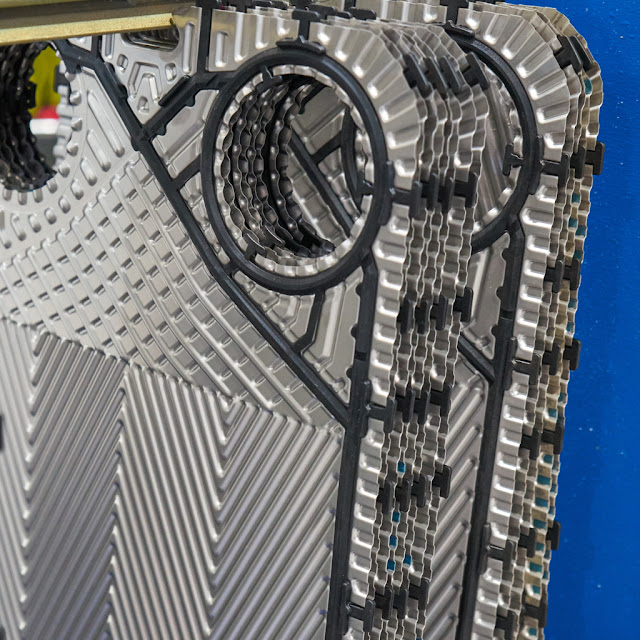Plate Heat Exchangers: Frequently Asked Questions (FAQ)
Since 1979 starting to work with Plate Heat Exchangers the day after Chemical Enginering graduation, I collected several questions so that I decided to resume more frequently asked.
Q) It is possible an accidental mixing between two fluids in PHE?
A) In principle no, because of double gaskets on the corner side where fluid is entering in the plate. In case of failure of first gasket, second one will deviate outside leaking. For this reason PHE is used in Food & Dairy as pasteurizer. In special cases (legionella risk, lub oil for transformers) a double wall plate is suggested, further safety in case of possible holes in one plate second one is keeping separate one fluid form another one.
Q) Fouling Factor in data sheet is specified for Shell & Tube Heat Exchangers; can I use same value for PHE?
A) No you should divide by ten. Fouling Factors has been topic of discussion since years. PHE FF myst be 1/10 of Shell&Tube HEX FF as finally API 662 recommended. There is a confusion among process engineers on FF to be used in PHE ans often EPC Contractors data sheets are mentioning FF for S&T HEX. Investigations demonstrated that these values are not giving good results in PHE since they often results in oversized units with premature fouling due to reduced velocity and turbolence.
Q) Material required in data sheets in 316 L. Why PHE Manufacturer is offering 316 only?
A) AISI 316 L (low carbon with percentage lower than 3%) is required when weldings are involved (like in a S&T HEX). Plates are pressed without any weldings, therefore there is no need of 316 L as plate material. If connections are with studbolts with lining in NBR or EPDM total unit is weldings free. If connections are welding neck (like Oil & Gas in the Middle East) then 316L is better and WPS must be described.
Q) For installation issues I have to change flow circuit: in other word primary side must be secondary side. Can I switch in PHE without any problem?
A) Generally yes. PHE are simmetric in case of same number of passes (1/1, 2/2 etc.) and major part of PHE are single pass.If mixing arrangement of plate pack is not identical different pressure drops could be possible. Of course inlet and outlet position must be changed for both fluids, otherwise counter-corrent arrangement would be co-corrent with different performance. Just in case of dirty fluid with particles (i.e.Nile river water) recommendation is inlet on bottom side so that particles will precipitate and clean water can flow up in the channel.
Q) Manufacturer offered a PHE with connections size smaller than my piping. Why?
A) The selection of connection size is using as parameter nozzle velocity with water 5.5 m/s. Major part of PHE design software switches to larger size if it is higher. Standard vwelocity in piping is 2-2.5 m/s sothat size of connections is normally smaller and conic reduction are often reduced. As a matter of fact piping area of PHE is only small portion of nozzles, because after tube is the sum of holes of plate pack.
Q) Data sheets are mentioning that PHE must have a "U" stamp.What does it mean?
A) Pressure Vessel Code in Oil & Gas application typical requirement is ASME VIII Div.1 with U stamp and nozzle load calculation according to API 662 table 2 severe conditions. PHE is considered a Pressure Vessel with flat covers and calculation is on tightening bolts on frame and mobile cover. In PHE design this include extra costs for material (SA-516 Gr.70 for frame, SA-193 Gr.B7 for bolts, SA-192 Gr.H2 for nuts etc.). Manufacturer must be U stamp holder (or frames should be manufactured by a Pressure Vessel subcontractor with workshop U approved). Sometimes is acceptable "according to ASME VIII Div.1 without U stamp" to get proper material with right stress calculation (i.e.frame thickness).
Q) My fluids are dirty, with fiber and particles. Can I use PHE?
A) Of course it depends of size of particles.In the past Tube in Tube HEX or Spiral HEX were common use. Recently channel size of special plate named "Freeflow" with 12 mm wide gap opened several applications like Ethanol plants. Furthermore in case of non-Newtonian fluid (i.e.Ketchup,Ice Cream) PHE had better performance. In worst cases like textile industry a Bernoulli filter was installed upstream PHE.
 |
Q) PHE Design Temperature is 180°C, but I know that Tmax in operation will be 140°C. Shall I mention to PHE Supplier?
 |
| Semiwelded plate pack |
Q) PHE Manufacturer mentioned Thermal length.What does it mean?
A) Thermal length is a dimensionless number that allows the design engineer to relate the performance characteristics of a channel geometry to those of a duty requirement.
Thermal length (theta) is the relationship between temperature difference DT on one fluid side and LMTD. The thermal length of a channel describes the ability of the channel to affect a temperature change based on the log mean temperature difference (LMTD)
(to be continued...)









Nice Post. For more information visit here: Heat Transfers
RispondiElimina